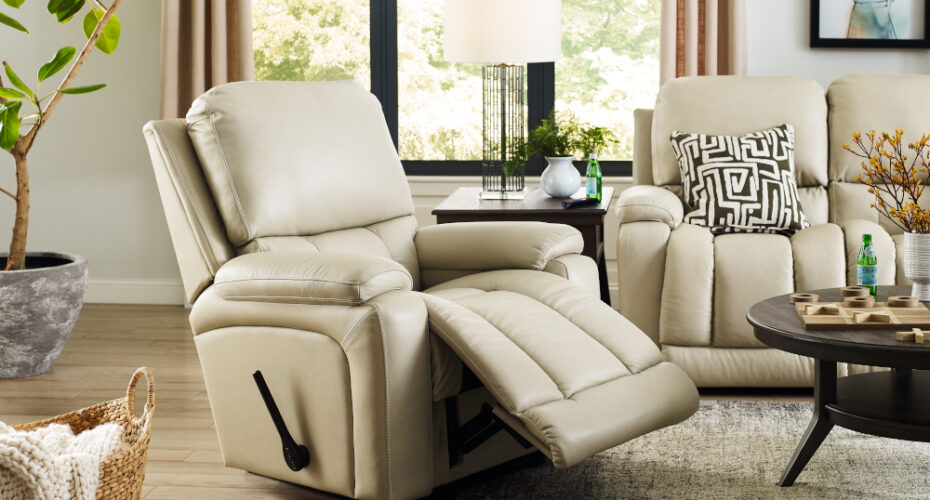The Complete Recliner Buying Guide: Everything You Need To Know
La-Z-Boy Southeast | November 21, 2025

Finding the right recliner isn’t just about picking something that looks comfortable—it’s about understanding how furniture design, body mechanics, and construction quality come together to create a chair that will support you for years to come. Whether you’re dealing with back pain, looking for the perfect reading nook, or just want to upgrade your relaxation game, this guide will walk you through everything you need to know.
Download this guide for a quick and easy reference while shopping for your recliner ⬇️
1) Understand Your Space
Before you fall in love with any recliner, you need to understand the physical reality of your room. And this goes beyond just measuring width—recliners are deceptive because they need clearance behind them to fully recline.
Here’s what you need to measure:
- The wall-to-wall dimensions of your room
- Any architectural features (windows, outlets, radiators)
- The distance from where you want to place the chair to the wall behind it
- Doorway widths (yes, you need to get it into the room!)
Most traditional recliners need 6-12 inches of clearance from the wall to recline fully. If space is tight, look for “wall-away” or “wall-hugger” designs that recline forward instead of backward. These ingenious mechanisms allow the chair to sit just a few inches from the wall while still giving you a full recline.
Sketch your room layout—it doesn’t need to be artistic, just functional. This visual reference will be invaluable when you’re standing in a showroom trying to imagine how a chair will fit in your actual space.
2) Get Properly Fitted
Here’s something most people don’t realize: a recliner that fits your partner perfectly might cause you chronic pain. Body height dramatically affects how a recliner supports you, and this is where many buyers make expensive mistakes.
The relationship between your height and recliner dimensions affects three critical support points:
The Footrest When fully extended, the footrest should support your entire lower leg, with your heels resting comfortably on the cushion. If it’s too short, your feet dangle off the edge, putting strain on your Achilles tendons. Too long, and your knees won’t bend naturally.
The Lumbar Support Your lower back has a natural curve that needs support. When the lumbar cushion hits the wrong spot on your spine—either too high or too low—you’ll end up with back pain even though you’re “relaxing.”
The Headrest If you’re tall and the chair back is too short, the top cushion will push your head forward into an unnatural angle. You might not notice it immediately, but this position strains your neck muscles and can lead to headaches.
Most manufacturers offer recliners in different scale sizes—petite (under 5’4″), small (5’5″-5’9″), tall (5’10”-6’2″), and extra tall (6’3″ and up). These aren’t marketing categories; they’re engineering specifications designed to align the chair’s support points with your body.
- Petite Recliners (5’4″ & Under)
- Small Recliners (5’5″ – 5’9″)
- Tall Recliners (5’10” – 6’2″)
- Extra Tall Recliners (6’3″ & Up)
We carry a wide variety of recliners in each category that will fit your height requirement.
3) Test Drive Like You Mean It
When you’re testing a recliner, don’t just sit for 30 seconds and move on. Spend at least 10-15 minutes in each position: upright, reclined, and fully extended. Here’s your evaluation checklist:
In the Upright Position:
- Do your feet touch the ground comfortably?
- Is there even pressure across your thighs, or do you feel a pressure point under your legs?
- Does your back make full contact with the backrest without gaps?
- Are the armrests at a comfortable height where your shoulders can relax?
In the Reclined Position:
- Does your lower back maintain contact with the lumbar support, or does a gap develop?
- Is your neck in a neutral position, or are you looking up or down?
- Can you breathe deeply and comfortably, or does the recline position compress your chest?
- Where does the footrest hit your ankle? It should support your entire calf.
Pay special attention to any spot where you feel increased pressure. That sensation will only intensify over hours of use. The perfect recliner should distribute your weight evenly, making you feel almost weightless.
4) Investigate the Construction
This is where most buyers lose thousands of dollars by not knowing what to look for. A recliner’s longevity is determined by what you can’t see: the frame, base, and internal structure.
The Frame Ask to see the underside of the recliner—if a retailer refuses, that’s a red flag. Quality recliners have a four-sided frame, often made from kiln-dried hardwood. This matters because people naturally push down on armrests when standing up. Two or three-sided frames will warp and split over time under this lateral pressure. A proper four-sided frame distributes that force evenly.
The Base You’ll find either hardwood or plastic bases. Hardwood bases are significantly more durable and can support more weight over time. Plastic bases are lighter and cheaper to manufacture, but they’re prone to cracking, especially in mechanisms that get used daily.
The Spring-Cushion Interface Quality recliners have a mesh or fabric barrier between the springs and seat cushion. Without this layer, the springs gradually work their way through the foam, creating uncomfortable pressure points and eventually tearing the cushion from the inside out. This is why some recliners feel perfect for the first year, then develop that dreaded “sitting on springs” feeling.
The Reclining Mechanism Metal reclining mechanisms outlast plastic ones by years. Check how smooth the recline action feels—any grinding, clicking, or resistance suggests loose tolerances or cheap components that will wear out quickly.
5) Choose Upholstery Wisely
The fabric or leather you choose affects more than just aesthetics—it impacts durability, maintenance, and even comfort in different seasons.
Leather
- Genuine leather breathes better than fabric and stays cooler in summer
- Develops a patina over time that many people find appealing
- Easier to clean spills (they sit on the surface rather than absorbing)
- More expensive upfront but often lasts longer
- Can feel cold in winter and sticky in humid weather
Performance Fabrics
- Modern synthetic fabrics can resist stains, moisture, and wear remarkably well
- Often softer and warmer to the touch than leather
- Wider variety of colors and textures available
- Some premium fabrics (like those treated with protectants) rival leather for durability
- Generally more affordable than genuine leather
Traditional Fabrics
- Cotton blends breathe well and feel comfortable year-round
- May require more careful maintenance and cleaning
- Can show wear patterns more quickly in high-contact areas
- Often the most budget-friendly option
Consider your lifestyle: Do you have pets? Kids? Do you eat meals in your recliner? How much sun exposure will the chair get? These factors should influence your fabric choice as much as color preferences.
6) Decide on Features and Upgrades
Modern recliners offer features that go far beyond basic reclining. Here are the options worth considering:
Power vs. Manual Recline Manual recliners use a lever or handle and your body weight to recline. They’re mechanically simpler and don’t require an electrical outlet. Power recliners use a motor to adjust, offering infinite positioning and requiring less physical effort—beneficial for people with mobility issues. The trade-off? Power recliners cost more and depend on access to electricity.
Heat and Massage Not just luxury features—heat therapy can alleviate muscle soreness, while massage functions help with circulation. If you deal with chronic back pain or spend long hours sitting, these features can provide genuine therapeutic benefit. Just know that the motors add weight and complexity to the chair.
Swivel Base A swivel base lets you rotate the chair without moving it, perfect for positioning yourself toward a TV, fireplace, or conversation area. Particularly useful in smaller spaces where you can’t rearrange furniture easily.
Rocker vs. Glider Rockers move in an arc (traditional rocking motion), while gliders move in a smooth horizontal plane. Gliders are generally gentler and quieter—preferred by many for reading or watching TV because they don’t create the up-and-down motion that can be distracting.
Handle Position and Style If you’re left-handed or have limited mobility on one side, you can often specify which side the reclining handle is positioned. Extended handles make operation easier for people with arthritis or grip strength issues.
7) Understand Your Delivery Options
The journey from showroom to living room matters more than you might think.
In-Stock vs. Custom Order Some retailers keep popular models in stock, meaning you can take them home immediately or get delivery within days. Custom-ordered recliners—where you select your specific fabric and features—typically take 6-12 weeks to manufacture. If you have a deadline (holiday gathering, recovery from surgery), plan accordingly.
Delivery Service Levels
- Threshold delivery: The delivery team brings the recliner to your doorstep or garage. You’re responsible for getting it inside and positioned.
- Room of choice: They bring it inside and place it in the room you specify, but you handle unboxing and setup.
- Full-service delivery: The team unboxes, assembles (if needed), places the recliner exactly where you want it, and removes all packaging materials.
For large, heavy recliners—especially power models that can weigh 150+ pounds—full-service delivery is often worth the extra cost. These professionals know how to navigate tight corners and protect your walls and floors.
Making Your Decision
A quality recliner is an investment in your daily comfort and long-term health. Take your time with this decision. Sit in multiple chairs. Compare construction quality. Think about how you’ll actually use the chair—will it be for quick TV watching, long reading sessions, or full-on napping?
The perfect recliner disappears beneath you. You should be thinking about your book or show, not adjusting your position or feeling pressure points. When you find that chair, you’ll know it.
If you’re shopping in the Southeast, La-Z-Boy showrooms offer complimentary design consultations to help with room planning and fabric selection—useful services when you’re trying to coordinate a new recliner with existing décor. But regardless of where you shop, use this guide to ask informed questions and evaluate quality. Your back (and your wallet) will thank you for doing the research.
Here are some additional online resources you may like to check out:
- 10 Best Selling La-Z-Boy Recliners
- 7 Features & Benefits of La-Z-Boy Recliners
- 5 Health Benefits of Sleeping in Your Recliner
We’d be happy to help you find a new recliner at any of our locations in NC, SC, and GA.



